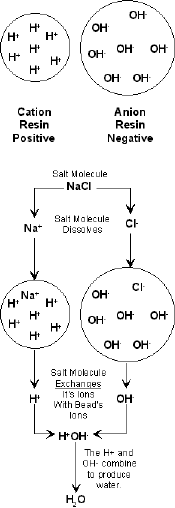Ion Exchange Systems
Ion Exchange Systems
An ion exchange system consists of a tank containing small beads of synthetic resin. The beads are treated to selectively adsorb either cations(positive) or anions(negative) and exchange certain ions based on their relative activity compared to the resin. This process of ion exchange will continue until all available exchange sites are filled, at which point the resin is exhausted and must be regenerated by suitable chemicals.
Ion Exchange Water Softening
 The ion exchange water softener is one of the most common tools of water treatment. Its function is to remove scale-forming calcium and magnesium ions from hard water. In many cases soluble iron (ferrous) can also be removed with softeners. A standard water softener has four major components: a resin tank, resin, a brine tank and a valve or controller.
The ion exchange water softener is one of the most common tools of water treatment. Its function is to remove scale-forming calcium and magnesium ions from hard water. In many cases soluble iron (ferrous) can also be removed with softeners. A standard water softener has four major components: a resin tank, resin, a brine tank and a valve or controller.
The softener resin tank contains the treated ion exchange resin – small beads of polystyrene. The resin beads initially adsorb sodium ions during regeneration. The resin has a greater affinity for multi-valent ions such as calcium and magnesium than it does for sodium. Thus, when the hard water containing the Calcium and Magnesium Ions is passed through the resin bed, the calcium and magnesium ions adhere to the resin, releasing the sodium ions until equilibrium is reached. The water softener has exchanged its sodium ions for the calcium and magnesium ions in the water.
Regeneration is achieved by passing a NaCl solution through the resin, exchanging the hardness ions for sodium ions. The resin’s affinity for the hardness ions is overcome by using a highly concentrated solution of brine. The regeneration process can be repeated indefinitely without damaging the resin.
Water softening is a simple, well-documented ion exchange process. It solves a very common form of water contamination: hardness. Regeneration with sodium chloride is simple, inexpensive and can be automatic, with no strong chemicals required.
The disadvantages of water softening become apparent when high-quality water is required. Softening merely exchanges the hardness ions in the water supply for normally less-troublesome sodium ions. Since the treated water contains sodium instead of calcium or magnesium, it is still unsuitable for many uses.
Demineralization/Deionization – See Deionization
Deionization refers to a specialized form of Ion Exchange where we use Hydrogen(H+) and Hydroxide(OH-) to replace the positive and negative Ions. See the page titled Deionization.
Ion exchange deionizers (DI) use synthetic resins similar to those used in water softeners. Typically used on water that has already been prefiltered, DI uses a two-stage process to remove virtually all ionic material remaining in water. Two types of synthetic resins are used, one to remove positively charged ions (cations) and another to remove negatively charged ions (anions).
Cation deionization (DI) resins exchange hydrogen (H+) ions with cations, such as calcium, magnesium and sodium. Anion deionization resins exchange hydroxide (OH-) ions for anions such as chloride, sulfate and bicarbonate. The displaced H+ and OH- combine to form H2O.
Resins have limited capacities and must be regenerated upon exhaustion. This occurs when equilibrium between the adsorbed ions is reached. Cation resins are regenerated by treatment with acid, which replenishes the sites with H+ ions. Anion resins are regenerated with a strong base which replenishes (OH-) ions. Regeneration can take place off-site with regenerated “exchange tank” deionizers brought in by a service company (See Exchange Type Portable Deionization), or regeneration can be accomplished on-site by installing regenerable deionizers and regeneration equipment and chemicals.
Two-Bed and Mixed-Bed Deionizers
The two basic configurations of deionizers are two-bed and mixed-bed.
Two-Bed deionizers have separate tanks of cation and anion resins. In Mixed-Bed deionizers, the anion and cation resins are blended into a single tank or vessel. Generally, mixed-bed systems will produce higher quality water with a lower total capacity than two-bed systems.
Deionization can produce extremely high-quality water in terms of dissolved ions or minerals, up to the maximum resistance of 18.3 megohms/cm. However, they do not generally remove organics and can become a breeding ground for bacteria, actually diminishing water quality where organic and microbial contamination are critical.
Failure to regenerate the resin at the proper time may result in harmful salts remaining in the water or even worse, being increased in concentration. Partially exhausted resin beds can increase levels of some dangerous contaminants due to the resin’s selectivity for specific ions, and may add particulates and resin fines to the deionized water.
For help with your Ion Exchange project, please contact us.